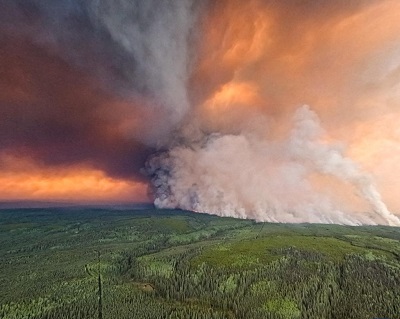Ottawa, (Samajweekly) Over 1,000 wildfires are still burning more than 100,000 square km of land in Canada, more than 600 of them out of control and growing rapidly, according to the Canadian Interagency Forest Fire Center (CIFFC).
The burnt area is equivalent to the size of Iceland or South Korea, Xinhua news agency quoted the CIFFC as saying.
This exceeds the record of some 76,000 square km set in 1989 and is four times of average Canadian wildfire burning area, which should be around 25,000 square km per year.
According to local media, more Canadians have been evacuated from their homes this year than in the last four decades, with more than 155,000 forced to leave due to fire and smoke.
Canada now has 5,500 domestic and some 3,300 international firefighters working together to put out the blaze.
However, the personnel deficit is still large compared to the scale of burning.
Roughly 2,500 firefighters are short of what is needed, said Mike Flannigan, a wildfire specialist and professor at Thompson Rivers University in British Columbia.
Till now two firefighters and a pilot have lost their lives in the combat against the monstrous natural disaster.
Meanwhile, the enormous carbon dioxide emissions from the unprecedented fires raised concerns among scientists and the public as they hamper international efforts to mitigate climate change.
The greenhouse gas emissions from the raging wildfires in Canada have exceeded one billion metric tons of carbon dioxide equivalent (CO2e), according to a study by Chinese scientists led by Liu Zhihua, a researcher from the Institute of Applied Ecology, Chinese Academy of Sciences.
The methane and nitrous oxide emissions are about 110 million metric tons of CO2 equivalent, and the total greenhouse gas emissions are about 1.11 billion metric tons of CO2 equivalent.
A similar estimate is made by Werner Kurz, a senior research scientist with Natural Resources Canada.
As of July 18, a preliminary estimate suggests roughly 1.42 billion metric tons of CO2 equivalent have been released from the fires so far, across Canada’s managed and unmanaged forests, Kurz said.
This is at least twice the emissions from all other sectors of the nation’s economy combined, which totaled 670 million metric tons of CO2 equivalent in 2021.
Kurz further noted that roughly the same amount of indirect carbon emissions will be released when the dead remnants of scorched trees decompose in the coming years.
Carbon emissions not only aggravate global warming but also create a dangerous feedback loop by creating conditions where forests are more likely to burn, further shrinking Earth’s carbon sink capacities.
A global challenge like wildfires requires global collaboration among all stakeholders.
The UN Environment Programme called for international and regional collaboration to tackle wildfires in its 2022 report on Rapid Response Assessment. Greater international collaboration enhances fire prevention capability through knowledge sharing for prevention, pre-suppression planning, and risk reduction activities.
For individual countries, effective measures should be taken to mitigate CO2 emissions from natural processes, said Liu, adding with regard to wildfires, strategies such as fuel treatment and improved forest management can be used to limit fire intensity and subsequently reduce CO2 emissions.
Restoration after fires is also encouraged because plant bodies are able to absorb carbon dioxide and will help remove some CO2 from the atmosphere, said Karen Hodges, a professor in ecology at the University of British Columbia.
As forest fires have become a major CO2 source, Liu said it is crucial to build better carbon emission monitoring and accounting systems, which include CO2 emissions from both human activities and natural processes, such as wildfires.
Echoing Liu, Hodges said governments should “get far more serious about climate change and policies that reduce fossil fuel emissions, and we need to do that globally”.









